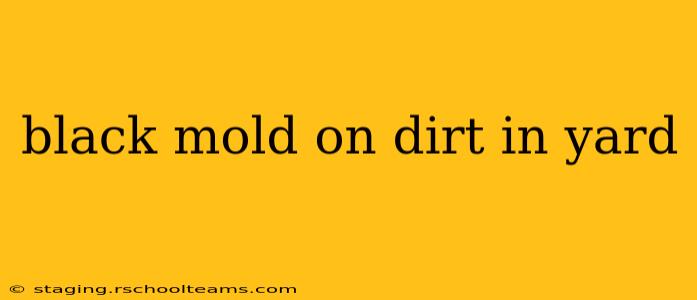Discovering black mold in your yard can be alarming. While not all black growths are harmful, understanding the potential risks and appropriate responses is crucial for maintaining a healthy and safe outdoor environment. This comprehensive guide will address common concerns and provide practical solutions for dealing with black mold on your soil.
What Causes Black Mold on Dirt?
Black mold, or more accurately, various types of black fungi, thrive in damp, shady conditions with plenty of organic matter. This often includes:
- Excess Moisture: Overwatering, poor drainage, and consistently damp soil create the ideal breeding ground for these fungi.
- Organic Debris: Leaves, grass clippings, and other decaying organic matter provide nutrients for mold growth.
- Lack of Sunlight: Shaded areas tend to stay moist and inhibit the drying process, favoring fungal development.
Is Black Mold on Dirt Harmful?
The harmfulness of black mold in your yard depends on the specific species and your level of exposure. Many soil fungi are harmless, playing a beneficial role in decomposition. However, some species can produce mycotoxins, which are potentially harmful substances. Direct contact is unlikely to cause significant harm to healthy adults, but precautions are still recommended.
What are the potential risks?
- Respiratory Issues: Inhaling mold spores, especially in large quantities, can trigger allergic reactions such as sneezing, coughing, and wheezing in sensitive individuals.
- Skin Irritation: Direct skin contact with some mold types can lead to irritation or allergic reactions in susceptible individuals.
- Mycotoxin Exposure: While less common, exposure to mycotoxins through ingestion or inhalation can lead to more serious health problems.
How to Get Rid of Black Mold in Your Yard
Tackling black mold effectively requires a multi-pronged approach focusing on eliminating favorable conditions and promoting a healthier soil environment.
Improving Drainage:
- Test your soil drainage: A simple test involves digging a hole and filling it with water. If the water doesn't drain within a few hours, you have poor drainage.
- Amend heavy clay soils: Adding organic matter like compost can improve drainage and soil structure.
- Install drainage systems: In areas with severe drainage problems, consider installing French drains or other drainage solutions.
Reducing Moisture:
- Adjust watering practices: Avoid overwatering. Water deeply but less frequently, allowing the soil to dry out between waterings.
- Increase sunlight penetration: Prune overhanging branches or remove dense vegetation to increase sunlight and airflow.
- Aerate the soil: Aeration improves water penetration and reduces compaction, helping the soil dry more efficiently.
Removing Organic Debris:
- Regularly clean up: Remove fallen leaves, grass clippings, and other organic debris promptly.
- Mulch properly: Use a thin layer of mulch to retain moisture without creating a damp environment conducive to mold growth. Avoid excessive mulching.
Using Natural Remedies:
Some people opt for natural solutions, such as applying diluted vinegar or baking soda solutions to affected areas. While these may help in some cases, they are not always effective against all types of mold and may not address underlying causes like poor drainage.
What if the Black Mold is on My House Foundation?
Black mold growing on the foundation of your house is a much more serious issue than mold on soil in your yard. This indicates potential moisture problems within your home's structure, potentially leading to significant damage and health concerns. Contact a qualified mold remediation specialist immediately if you see black mold on your foundation. Do not attempt to address this yourself.
How to Prevent Black Mold in Your Yard
Prevention is key to maintaining a healthy yard free from excessive mold growth. By following these preventative measures, you can reduce the likelihood of mold problems:
- Maintain good drainage: Regularly check and improve your yard's drainage system.
- Proper watering: Avoid overwatering and water deeply but less frequently.
- Keep your yard clean: Remove fallen leaves and other organic debris regularly.
- Promote air circulation: Prune trees and shrubs to allow for better sunlight and airflow.
By understanding the causes, risks, and solutions for black mold in your yard, you can take proactive steps to maintain a healthy and safe outdoor space for yourself and your family. Remember, if you have any concerns about significant mold growth or potential health risks, it's always best to consult with a professional.
